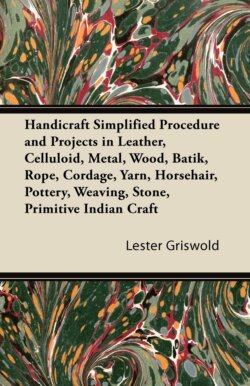Читать книгу Handicraft Simplified Procedure and Projects in Leather, Celluloid, Metal, Wood, Batik, Rope, Cordage, Yarn, Horsehair, Pottery, Weaving, Stone, Primitive Indian Craft - Lester Griswold - Страница 34
На сайте Литреса книга снята с продажи.
Cut Out Decorations
ОглавлениеUnderlay.
Areas may be cut out and removed from the leather and an underlay of colored leather attached to the back. The knife should cut through the leather into a piece of soft wood, preferably the end grain, and make a clean incision in the leather. The outer leather with the cutout design complete is placed on a smooth flat surface with the under side upper-most, and the cement is applied around the openings. Care must be taken not to leave any excess glue on the edges, as it will spread into the cutout area and mar the design.
The underlay is placed upon the outer piece, right side down, and smoothed with the hand. Then turn the whole over and press each edge of the design firmly against the underlay. Any surplus cement may be removed later as it begins to harden but before it is entirely dry.
Overlay.
A reverse procedure is used in making overlay or applique decorations. The design area is cut as indicated above but the area removed must be left intact for mounting on the surface of the article to be decorated. Stencil designs may be readily adapted to either underlay or overlay decorations.
Inlay.
Tooled or painted inlays of tooling leathers may be applied effectively to non-tooling leathers. Circular, oval or rectangular areas decorated with monograms, emblems or other designs are inset, the corresponding section of the project to be ornamented having been cut out, so that an even surface is preserved. Both must be cemented firmly to a lining after the inlay is in place.
An interesting type of inlay decoration was used by the 16th Century Italian bookbinders. The impression in relief was obtained from dies cut in intaglio. Vellum or rawhide was pressed damp upon the die and left to dry. On removal the cavities were filled with a composition or clay to preserve the shape of the figures. After being transferred to the center of the leather binding they were sometimes richly gilded and painted. It is thought that these medallions were first made from molds which had been made for the purpose of casting plaques for the ornamentation of sword panels.
Similar inlays of rawhide may be adapted to the decoration of leather covered Chests, Cases, Book Ends, Desk Sets, and any article which will have a stiff firm base.
Carved and Stamped Decoration for Cowhide and Vealskin
This method of decorating leather is employed by the makers of saddles and other cowboy equipment. Articles decorated with carved and stamped designs have been in great demand by the old time cowboys, and recently by dude ranches and rodeo performers.
Some of the finest specimens in this art have been produced in Old Mexico where the leather worker’s skill has been enhanced by that of the Silversmith. Conchas, metal covered horns, saddle trees and cantles have enriched the product of the leather worker for many years.
Carved and stamped decorations applied to cowhide is described on pages 57 to 61.
Fig. 1
Fig. 2
The application of a carved motif to a small coin purse of tooling veal is illustrated in Fig. 1. The procedure follows Fig. 2 and assembly detail is given on page 75.
1.Trace the design on the leather which has been evenly moistened, Cowhide strap leathers should be soaked in water for a few minutes and then wrapped in a moist cloth and permitted to stand several hours or preferably over night.
2.Score or incise the outline with a Swivel Cutter, as indicated in Fig. 45-A, page 54.
3.Open the incised lines by spreading them apart with the tip of a modeling tool as indicated in Fig. 45-B, page 54.
